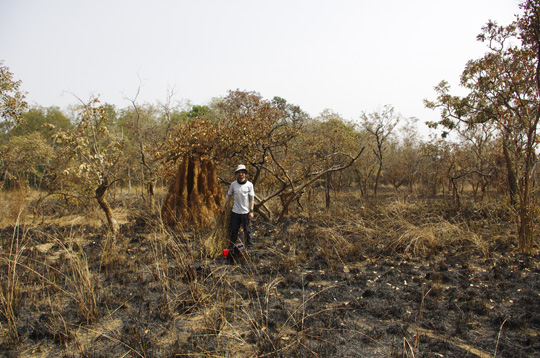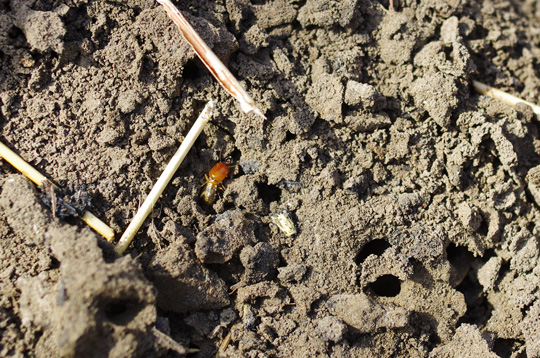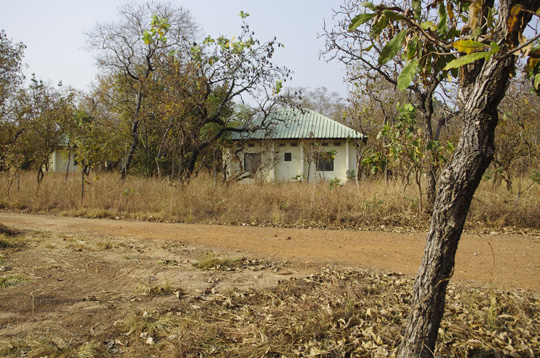Hunters and gatherers
Freiburg, Jun 28, 2017
For his practical research project, Biology student Adrian Hiss investigated the competitive behavior of termites in Côte d'Ivoire's Comoé National Park.
 Macrotermes bellicosus termites build mounds up to nine meters tall. Adrian Hiss investigated the insects' feeding and competitive behavior. Photo supplied by Adrian Hiss
Macrotermes bellicosus termites build mounds up to nine meters tall. Adrian Hiss investigated the insects' feeding and competitive behavior. Photo supplied by Adrian Hiss
Early in the morning when the air is still cool and the bush is quiet, Adrian Hiss makes his way out into the savannah. He does the rounds of 21 termite hills, distributing grass, dry leaves, and cellulose in the form of cardboard rolls all around them in every direction. He assesses what has changed since the previous evening, digs up the earth around the mound a little bit, and observes the termites which appear. He does the same thing in 21 other selected areas which have no termite mounds. Next morning he will come back to see whether the termites have eaten the food he left. Some of them he will collect so that he can have them analyzed at a gene laboratory in Germany. "You can't tell a termite's species just by looking at it," Hiss explains. "To find out exactly which termites we have here, we have to take them back."
Hiss has not been working on termites for all that long. In January 2017 he flew to Ivory Coast for three weeks to support a research project by the team headed by Professor Judith Korb on the competitive behavior of Macrotermes bellicosus (M. bellicosus) termites. These two-to-three-centimeter-long creatures live in mounds up to nine meters high. But M. bellicosus are not the only termites in Comoé National Park – other species live in underground nests, even around the M. bellicosus mounds. In order to determine the influence of the mound builders, there are test areas around the mounds and other test areas where there a none - so that the researchers can be sure that there are no M. bellicosus living there. Hiss laid out food and collected termites in order to find out whether the various species come to the food in a particular order, and whether there are differing food preferences. This has given Hiss the foundations for further studies. The long-term aim is to find out whether M. bellicosus competes with other termite species, whether they drive them away, or even if they may be necessary to make the soil habitable for other termite species. Previous field research suggests that M. bellicosus promotes biological diversity; now the aim is to discover the mechanism behind that.
 A Macrotermes bellicosus termite. The insects live and feed mostly in the dark - in their mounds or underground. Photo: Adrian Hiss
A Macrotermes bellicosus termite. The insects live and feed mostly in the dark - in their mounds or underground. Photo: Adrian Hiss
Nature up close
When Adrian Hiss talks about his field research, it quickly becomes clear that he really enjoys his work in Ivory Coast. That's not just because he finds insects interesting, but because he has dreamed of conducting fieldwork since he was a child. "It is exciting being outdoors and observing processes which have developed over the course of evolution." On top of that, he says, it has been a great privilege to be able to work on one single animal species so long and so intensely. "You learn a lot in a very short time. When you spend time looking at the animals every day, you enter a whole new world."
Contact with other cultures also teaches you about their customs - and to better understand the problems in other countries, he stresses. For instance, Hiss was confronted with the belief in the healing powers of animal products and the resultant poaching. Traders at local markets offer products such as lion sperm and elephant skin. "It's not tourism which is the main reason for poaching. It's primarily the conviction that animal products can bring healing and blessings," he explains.

At the research station on the edge of Comoé National Park, researchers and employees live in small stone buildings. Photo: Adrian Hiss
Experiencing the research spirit
Working with other researchers has been a boon to Hiss. "You get a more direct insight in to their work and into other projects. The research spirit is infectious; everyone wants to go out and discover something new." Among the researchers he met at the National Park was one who is working with West African chimpanzees. Talking with him - and also the seemingly endless palm oil plantations - brought it home to Hiss just how much Western industry contributes to the destruction of the habitats of chimps and other animals.
Hiss says field research complements his studies perfectly. "It was easier to remember what I'd learned, because I connected it with experience," he says. However, he does not recommend transporting toilet paper cardboard roles by air. "When they X-rayed the suitcases, the airport employees were very concerned and it was very hard to convince them that they were not hazardous materials but important items for our research. Despite hiccups like this, despite bushfires and hyaenas howling at night, Hiss wants to stick with field research. His Bachelor's thesis is about ants in northern Tunisia, and after that he would like to do more fieldwork - investigating maybe whales or big cats.
Julia Dannehl
Further reading
Website of the research station in Comoé National Park
Article in the research magazine uni'wissen on Judith Korb's research
Association of friends
Adrian Hiss's research project in Ivory Coast was sponsored by the Association of Friends of the University of Freiburg. The non-profit organization was founded in 1925 to help needy students. With some 800 members and the foundations it administers, the association is still supporting primarily students, for example with financial aid for excursions and research projects, scholarships and prizes for outstanding performance.

